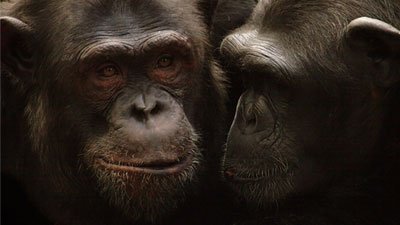
Monkey See, Monkey Talk: Ape Communication
ABC NEWS: “Hello, How Are You Doing?”
An abridged version of this story, which describes ABC NEWS correspondent John Berman’s interactions with apes of the Great Ape Trust, could easily convince the casual reader that apes are as intelligent as humans. Let’s take a quick look at a few paragraphs:
The Great Ape Trust [...] is home to seven bonobos—a close relative of the chimpanzee—and three orangutans. But if you think Iowa [home of the Great Ape Trust] might be a strange place for them to live, don’t say it out loud … these apes understand English.
You can talk to the apes, and they know what you are saying.
[Researcher Bill] Fields swears he has heard [bonobo] Kanzi try to say “thank you.”
Indeed, Berman presents his interview with Kanzi as a duel of wits, describing how he “read Kanzi a series of words, and then without fail, he hit the corresponding lexigram symbol on a touch screen.”
Scientists may rush to see “intelligence” when the evidence more accurately indicates mimicry, especially when it comes to language.
Let us make it perfectly clear—we do not deny that, as animals go, apes are intelligent, and certainly seem “almost human” at times. However, scientists may rush to see “intelligence” when the evidence more accurately indicates mimicry, especially when it comes to language. Berman’s interview shows Kanzi correctly hitting the lexigram corresponding to Berman’s spoken word; however, to what extent is this more complex than an intelligent dog that can respond to a spoken command with the proper behavior?
Also, many animals not considered humans’ evolutionary cousins have shown similar adaptiveness and intelligence, as we have shown in past issues of News to Note. From clever crows to smart cetaceans to “man’s best friend,” God clearly gave numerous animal species the capacity to communicate with us. This ability extends to many apes.
So what’s driving the focus on primate intelligence? Berman inadvertently reveals the motivation in his final paragraph: “Bonobos share 98 percent of their DNA with humans[.]” That widely popularized inaccuracy, often cited as ostensible evidence of evolution, continues to fuel the misconception that save for a few small differences, humans and apes are fundamentally the same. The Bible, on the other hand, presents both humans and apes as made by the same Creator (on the same day), which explains our similarities, yet describes humans as uniquely made in the image of God—which explains our vast differences.
Remember, if you see a news story that might merit some attention, let us know about it! (Note: if the story originates from the Associated Press, Fox News, MSNBC, the New York Times, or another major national media outlet, we will most likely have already heard about it.) And thanks to all of our readers who have submitted great news tips to us.
(Please note that links will take you directly to the source. Answers in Genesis is not responsible for content on the websites to which we refer. For more information, please see our Privacy Policy.)
Recommended Resources

Answers in Genesis is an apologetics ministry, dedicated to helping Christians defend their faith and proclaim the good news of Jesus Christ.
- Customer Service 800.778.3390
- © 2024 Answers in Genesis






